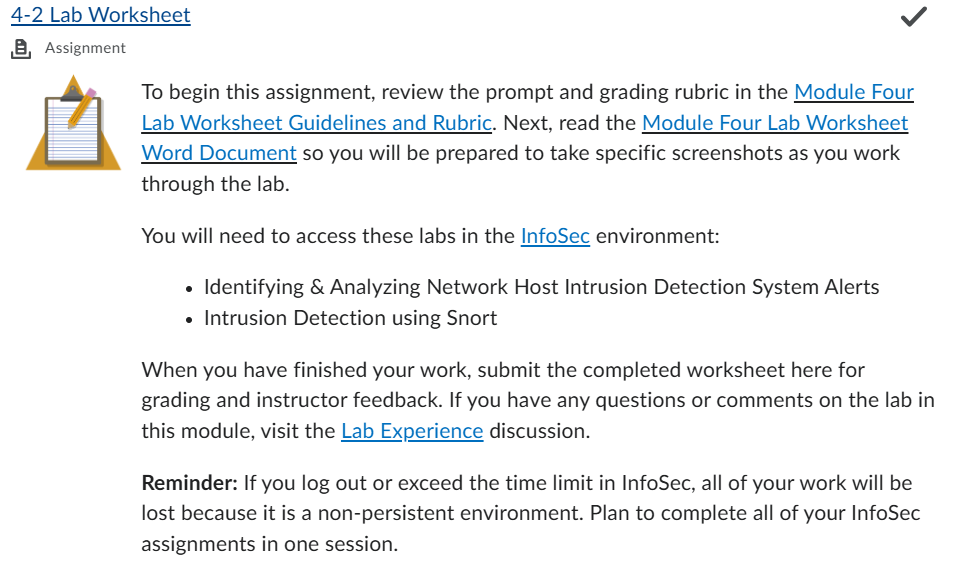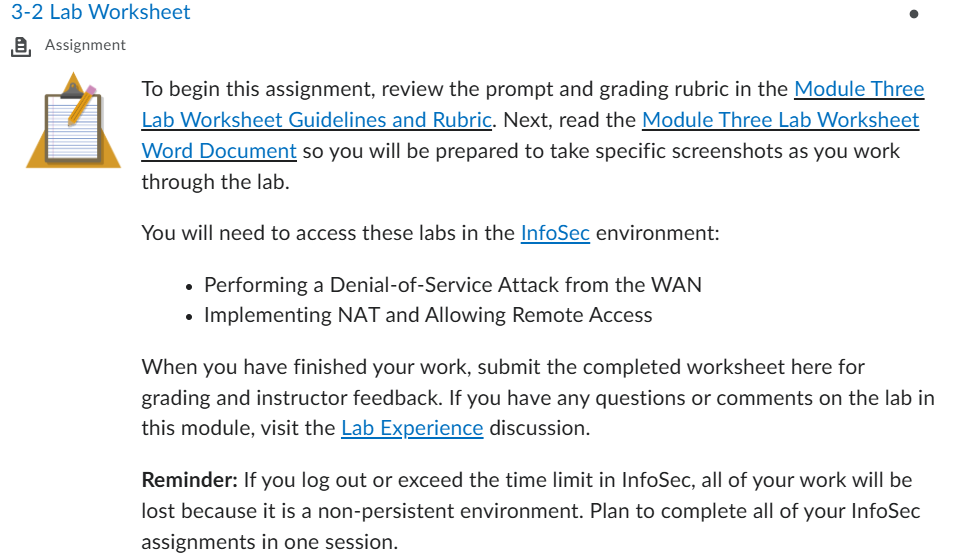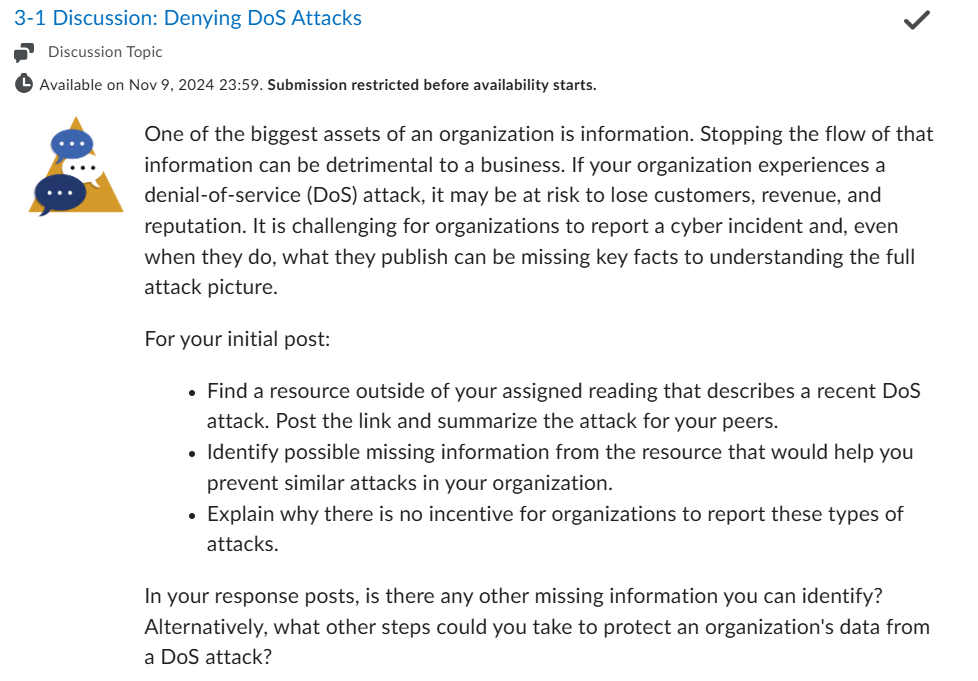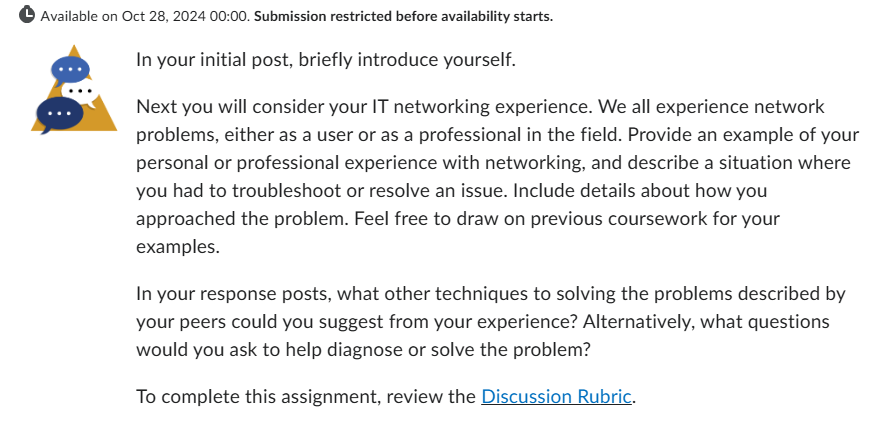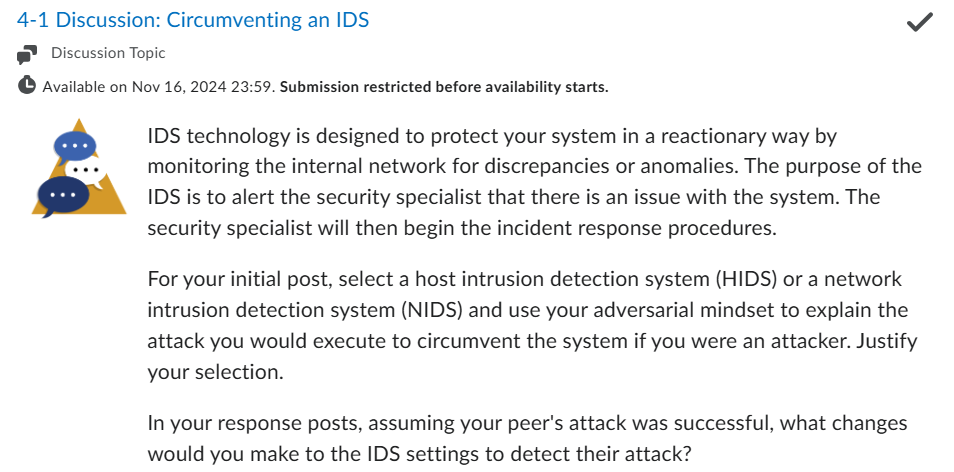
IDS technology is designed to protect your system in a reactionary way by monitoring the internal network for discrepancies or anomalies. The purpose of the IDS is to alert the security specialist that there is an issue with the system. The security specialist will then begin the incident response procedures.
For your initial post, select a host intrusion detection system (HIDS) or a network intrusion detection system (NIDS) and use your adversarial mindset to explain the attack you would execute to circumvent the system if you were an attacker. Justify your selection.
In your response posts, assuming your peer's attack was successful, what changes would you make to the IDS settings to detect their attack?
Sample Post
Hello everyone,
Intrusion Detection Systems (IDS) are critical in a cybersecurity strategy, identifying and alerting administrators to potential threats. In particular, Network Intrusion Detection Systems (NIDS) monitor network traffic to detect anomalies. However, no system is foolproof, and attackers often exploit weaknesses in NIDS to infiltrate systems undetected. This discussion explores a common technique used to circumvent an NIDS, focusing on evasion through packet fragmentation while drawing on real-world examples to highlight the practical implications.
Packet fragmentation is a widely known evasion technique targeting NIDS. In this approach, attackers divide malicious payloads into smaller packets that conform to standard traffic patterns. The fragmented packets can bypass inspection thresholds or confuse detection algorithms, especially if the NIDS is configured with insufficient reassembly capabilities. For example, the 2010 attack against the South Korean defense network utilized fragmented packets to bypass perimeter NIDS, demonstrating the efficacy of this technique (Kim et al., 2012). Tools like FragRoute enable attackers to automate fragmentation, emphasizing the need for robust NIDS configurations.
Another notable case involved the infamous Stuxnet malware. By leveraging fragmented packets and obfuscating payloads, Stuxnet circumvented monitoring systems to infiltrate critical infrastructure (Langner, 2013). These examples underscore the importance of advanced NIDS solutions capable of reconstructing fragmented packets accurately and analyzing their content in real time.
In conclusion, while NIDS provides significant protection against unauthorized access, adversaries can exploit configuration weaknesses and limitations in detection mechanisms. Packet fragmentation exemplifies the sophistication of evasion techniques, as demonstrated in high-profile cases like Stuxnet and the South Korean defense breach. Organizations must invest in updated NIDS solutions and proactive monitoring to mitigate these threats effectively. Cybersecurity professionals can better secure their networks against such vulnerabilities by understanding adversarial methods.
References:
Kim, J., Park, S., & Lee, H. (2012). Advanced evasion techniques for intrusion detection systems. Journal of Computer Security, 20(1), 25-36.
Langner, R. (2013). To Kill a Centrifuge: A Technical Analysis of What Stuxnet’s Creators Tried to Achieve. Langner Group.
Scarfone, K., & Mell, P. (2012). Guide to Intrusion Detection and Prevention Systems (IDPS). NIST Special Publication 800-94.
Sample Reponse
Hi [peer's name],
Thank you for the post and examples provided of a successful attack using packet fragmentation to evade an IDS. It is especially fascinating to hear about an attack that was even able to evade government-level detection systems.
Packet fragmentation seems to be an ongoing issue for even modern IDS systems to handle. From what I can tell, one of the defenses to this kind of attack is to use application-level monitoring with deep packet inspection to look into packets and determine if their contents could be reconstructed as malicious code (EcyberTekTrooper, 2024). Another defense for packet fragmentation techniques is to incorporate anomaly-based detections. Even though fragmented packets may not be flagged as matching malicious code signatures, they are still an anomaly on the network (EcyberTekTrooper, 2024).
Lastly, it is important to remember that even if an attack technique is able to evade existing detection methods, such as in the case of a zero-day vulnerability, following recommended guidelines and security frameworks will likely lesson the damage of successful attacks. Things like segmented networks, routine network audits, and cultivating a security aware culture are all effective methods for reducing the impact of attacks that evade network detection methods (EcyberTekTrooper, 2024).
Thanks for the great post!
Reference
EcyberTekTrooper. (2024, March 20). Evading Detection with Nmap’s Advanced Packet Fragmentation. Medium. https://medium.com/@flyparamotorguillermo/evading-detection-with-nmaps-advanced-packet-fragmentation-6bf1aec9833b
